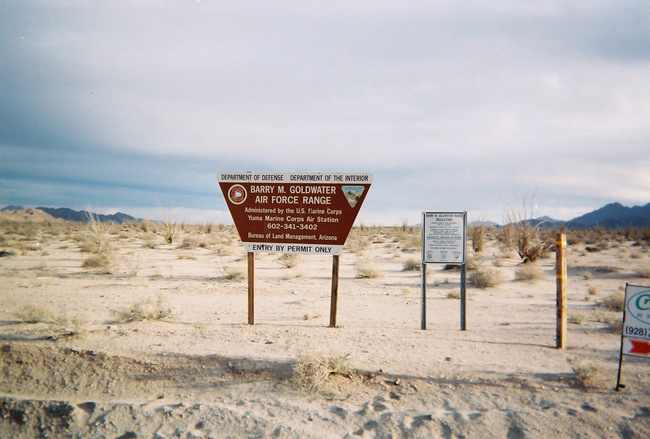The U.S. Fish and Wildlife Service (Service) recognizes the Barry M. Goldwater Range as this year’s recipient of the prestigious Military Conservation Partner Award during a ceremony planned on June 9 at Luke Air Force Base, AZ.
The Military Conservation Partner Award is a national award presented annually to a military installation whose efforts represent significant conservation accomplishments achieved in partnership with the Service and other conservation agencies.
The award was created by the Service to recognize military installations that have made significant natural resource conservation achievements through cooperative work with the Service, state and local government, and other organizations. Such achievements may include the conservation, protection, and restoration of important habitat for a variety of species – including endangered and native species – on military lands.
The 1.7 million-acre Barry M. Goldwater Range is nationally significant as a major component of the largest remaining tract of relatively unfragmented Sonoran Desert in the United States. The land is managed cooperatively by the 56th Fighter Wing Range Management Office at Luke Air Force Base, Arizona, and the Yuma Range Management Department at Marine Corps Air Station Yuma, Arizona.
“We value our many partnerships with the military and appreciate the role military lands play in conserving fish, wildlife, plants and their habitats across the United States,” said Service Director Dan Ashe. “By supporting threatened and endangered species recovery and building the scientific foundation for future conservation efforts, the 56th Fighter Wing and the Marine Corps Air Station Yuma are leading the way for proactive conservation efforts on military lands.”
The Barry M. Goldwater Range (BMGR) and the Service have a long-standing cooperative conservation relationship that supports one of the largest single landowner segments (about 1.5 million acres) of Sonoran Desert in the United States. This unique eco-region has the highest diversity of native plants of any desert in the world, includes over 2,500 pollinator species, as well as over 600 native fish and wildlife species, including over two thirds of all migratory birds species that occur in the U.S., Mexico, and Canada. There are roughly 300-400 native plants and 320 wildlife species on the BMGR, including three federally-listed species (Sonoran pronghorn, lesser long-nosed bat, and the acuña cactus) and approximately 90 at-risk (state protected) wildlife species.
The Service’s Southwest Regional Director, Dr. Benjamin Tuggle, is honored to present the award to the recipient, “I’m always humbled when I visit our partner military organizations and see the dedication they bring not only to the protection of our country but also to the protection of natural resources,” Tuggle asserts. “It’s a privilege to partner with the Armed Forces to balance stewardship and natural resource conservation on military lands with the military mission. Military forces – our Airman and the Marines – in Arizona have made such a huge difference in ensuring that our precious wildlife resources will endure not just for us to enjoy, but for future generations of Americans to appreciate.”
For over 45 years, since the passing of the Sikes Act, the Service has worked in cooperation with the military to conserve fish and wildlife resources found on the 30 million acres of land owned and managed by the Department of Defense. These lands are valuable for maintaining survival and diversity of many important species. In recent years, natural resource management on installations has attained even greater significance with the Department of Defense, Congress, and the public leading to the creation of integrated natural resource management projects under the Sikes Act. In response, many military installations have accomplished exceptional conservation work using partnerships with agencies.





